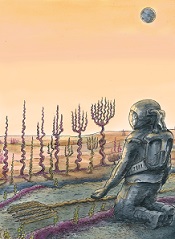“Frame Rate” by Mike Jack Stoumbos
“The Soul Hypothesis” by Robert L. Jones III
“Brown Noise” by Peter Ormosi
“Committed” by Matthew Ross
“A True Martian Red: A Brief History Of Early Viticulture On Mars” by Kara Race-Moore
“The Story of Atoms” by Geoffrey Hart
“The Arbiter” by Conrad Gardner
“Preliminary Threat Analysis Of Security Guests Intercepted On A “Cultural-Intellectual” Mission In Possession Of Plato’s Dialogues” by Thomas White
“Xenogram: A Chronology Of The Global Erasure Of Vowel Number Three, And the Merger Of Man” by Charles Ta
“The Convert” by Brett Abrahamsen
Reviewed by Emmanuel Mihai
We are pleased to have the opportunity to read a series of stories from Sci Phi Journal that belong to the science fiction genre, this time the hard science fiction side. The first, “Frame Rate,” explores the excitement of a space botanist from a purely naturalistic perspective as he discovers what we would call the first signs of intelligence or sapience. There’s nothing bombastic or grand in its implications, just a contemplative reminiscence of the character discovering plants that manifest what we would call a primitive form of intelligence.
Further, Robert L. Jones III‘s story “The Soul Hypothesis” explores a topical subject, namely that of artificial intelligence, taken, in an sf scenario, to its logical conclusion: not just the reproduction of the human mind, but the synthesis of the human being. The real existential danger of substituting the born, and not the created, human being is analyzed through a philosophical paradigm of understanding the world: creation can never be, at least on an ontological level, superior to the creator. A weak point of the narrative would be the long explanatory paragraphs, which could have been more easily integrated into the story.
Continuing on the pessimistic and ominous note of the future sterilizing of humanity in various ways, “Brown Noise” brings to the fore the issue of sterility of mind, the annihilation of autonomy. On a humorous note, we compare Peter L. Ormosi‘s story to the future envisioned and desired by Yuval Harari and Klaus Schwab. You know the drill, “eat ze bugs (or fake meat, whichever delicacy you prefer), you will own nothing and you will be happy.”
As an interlude, Matthew Ross’s “Committed” satisfies the craving to witness an event of cosmic magnitude. Short and sweet.
Written as a work of authentic research, “A True Martian Red” is an effort that transcends literary boundaries, combining elements of alternate history, science fiction, chemistry, historiography, political science and botany. The result is a pseudo-story that anchors its veracity through fictional footnotes, thus creating the impression of a genuine piece of history. One of our favorite stories, mostly because of its creativity. A toast to the Martian wineries (and to Kara Race-Moore)!
Continuing the creative trend, “The Story Of Atoms” is a cute little foray into the world of elementary particles, in which mister Geoffrey Hart anthropomorphizes particles and places them in the context of the Creation story in the Bible. The father-daughter dynamic between the two Higgs bosons is a comic delight but it doesn’t save the story from being, after all, a positivist interpretation of an age-old story. Still, if we force ourselves, we can see it as being read for educational purpose.
Similar to the Martian wine story, Conrad Gardner forges, like his characters, a magical world (this time) explored through museum exhibits. “The Arbiter,” the weapon around which the story revolves, as well as the title of the story, is described to the audience, giving the reader a glimpse of this Spain or Italian city-state’s influenced world. We would like to explore the rest of this museum!
In his story “Preliminary Threat Analysis Of Security Guests Intercepted On A “Cultural-Intellectual” Mission In Possession Of Plato’s Dialogues” Thomas White wonders if Diogenes would be considered a hobo nowadays? Would he use disinfectant after sneezing in 5145, the Year of Our Hygieia? White provides the answers to these difficult questions through his dystopian story, not lacking in absurd humour.
Ah, what would a science fiction magazine (or a collection of stories) be without the classic race of aliens acting as a collective, whose ambition is to annihilate the will of the individual and integrate them into a group, for the greater good?
In Charles Ta’s “Xenogram: A Chronology Of The Global Erasure Of Vowel Number Three, And the Merger Of Man” cosmic horror (but fleshy) Borgs abound. They have read 1984 and thus understand the significance and importance of language. Ta dots the i’s not only because he wrote this short story, but also because he wrote it without using the letter “i” once.
“The Convert” (also the protagonist) discovers that Pascal’s wager may hold true. And maybe mister Brett Abrahamsen tries to tell us that the saying “as in life so in death” is not just a blank metaphor. Who knows?
All in all, this is a solid issue and I look forward to reading future issues. Most of the enjoyment came from the meta-pseudo historiography-like stories—really creative stuff!
Emmanuel Mihai notes that since he is writing his masters thesis, the article about Utopia(s) in this issue came in really handy and he will cite it in his work.
 SciPhi Journal
SciPhi Journal